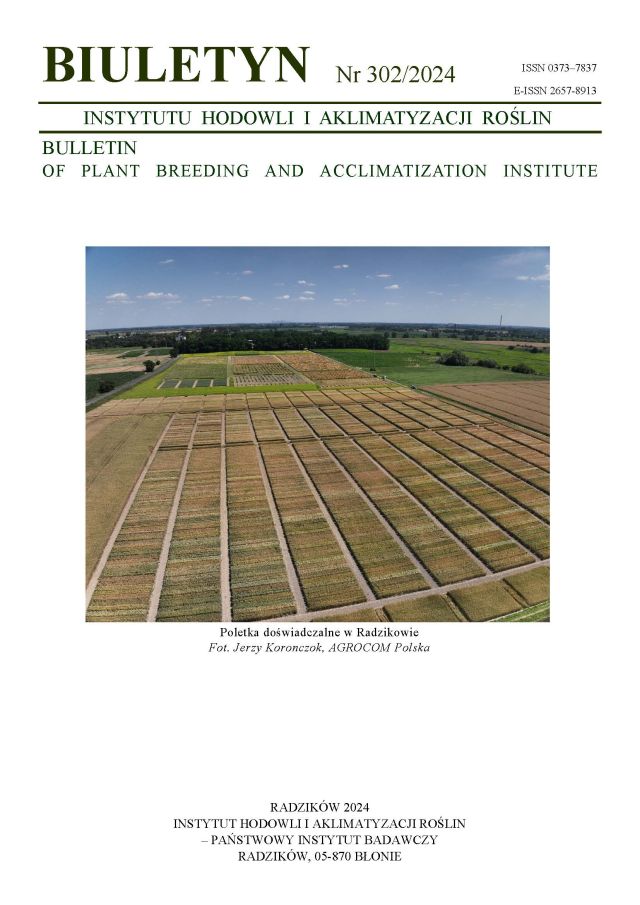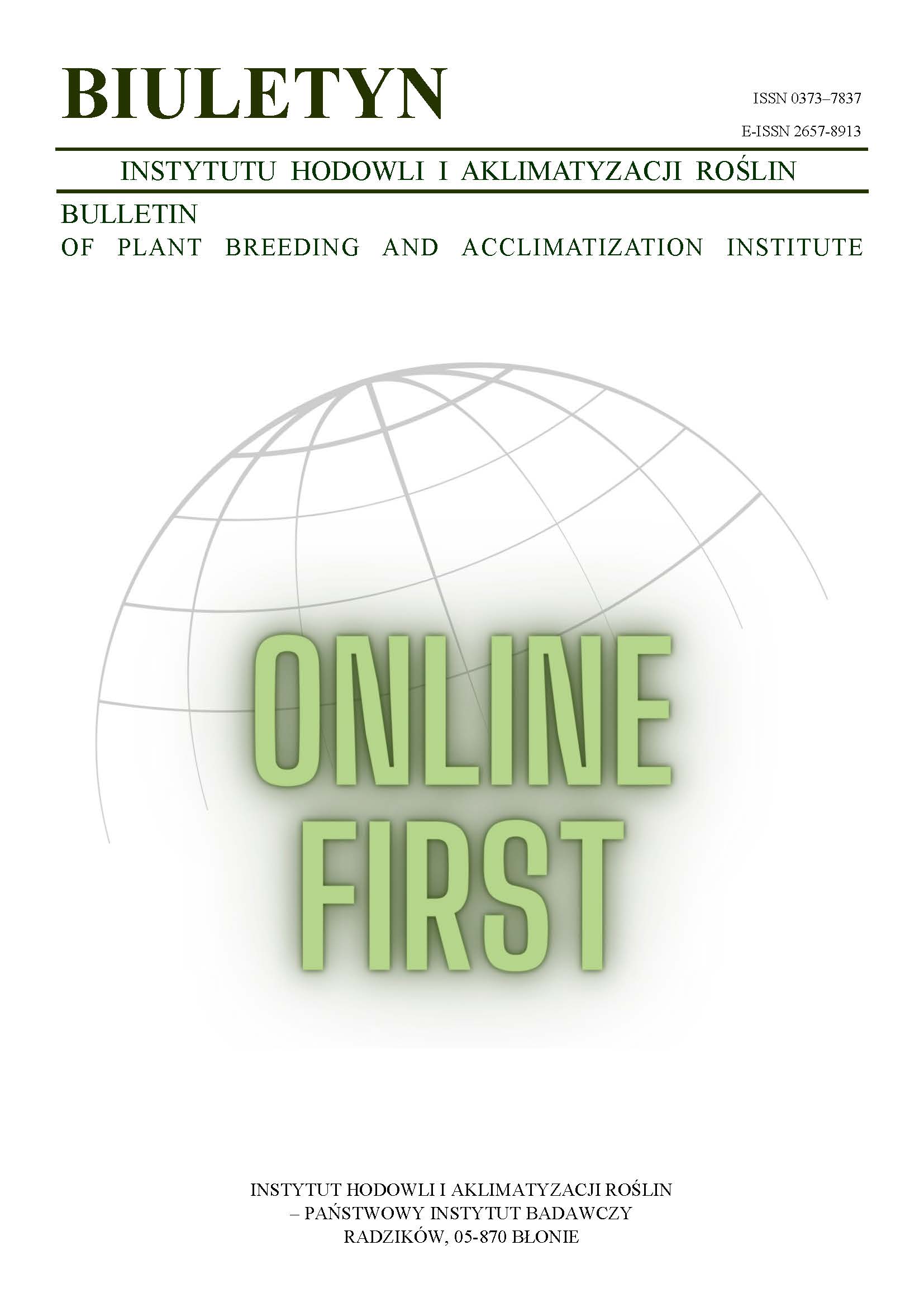Comparison of response of six-row and two-row winter barley cultivars to nitrogen fertilization level and sowing date
Danuta Leszczyńska
iung@iung.pulawy.plZakład Uprawy Roślin Zbożowych, Instytut Uprawy Nawożenia i Gleboznawstwa — PIB, Puławy (Poland)
Kazimierz Noworolnik
Zakład Uprawy Roślin Zbożowych, Instytut Uprawy Nawożenia i Gleboznawstwa — PIB, Puławy (Poland)
Abstract
The response of 3 two-row and 3 six-row cultivars of winter barley to nitrogen fertilization (0, 30, 60, 90 kg N/ha) and sowing date (7–9, 17–19 and 27–29 September) was investigated in microplot experiments in the years 1998–1999. The response of 2 another two-row and 3 six-row cultivars was investigated in similar experiments in the years 2000–2001. All the cultivars responded with increase of grain yield to the increase of nitrogen fertilization up to 60 kg N per ha. The six-row cultivars (especially Bursztyn) showed higher increase than the two-row cultivars. In the years 1998–1999, interaction of the cultivars and nitrogen fertilization at the dose of 90 kg per ha was caused by higher yield increase of the six-row cultivars as compared to the two-row cultivars. High yield was reached at the early sowing time and good winter survival. Under poor survival caused by smothering and snow mould infection the yields were smaller at the early sowing date (especially for the two-row cultivars). The medium date was most suitable for winter barley. The two-row cultivars (in particular Bombay) were more sensitive to delayed sowing when compared to the six-row ones. Variability of grain yield, in dependence on the studied factors, was related to differentiation in number of ears per unit area, but the seed number per ear and weight of 1000 seeds did not vary significantly.
Keywords:
cultivars, grain yield, nitrogen fertilization, sowing date, winter barleyReferences
Ambolet V., Cordon D., Duboin J. 1986. Choix d,un niveau d, intensification sur les exploitations cerealiers du barrois. Perspect. Agr. 107: 25 — 31.
Google Scholar
Anderson W. 1985. Differences in response of winter cereal varieties to applied nitrogen in the field. Field Crops Res. 11: 353 — 385.
DOI: https://doi.org/10.1016/0378-4290(85)90116-9
Google Scholar
Bundessortenamt. 2000. Beschreibende Sortenliste. Landbuch Verlag.
Google Scholar
Bundessortenamt. 2001. Beschreibende Sortenliste. Landbuch Verlag.
Google Scholar
COBORU 2003. Lista opisowa odmian. Słupia Wielka.
Google Scholar
COBORU 2002. Syntezy wyników doświadczeń odmianowych — Zboża ozime. Słupia Wielka.
Google Scholar
COBORU 2003. Wyniki porejestrowych doświadczeń odmianowych — Zboża ozime. Słupia Wielka.
Google Scholar
Denner P., Nitsch V. 1986. Hohe Getreideertrage mit guter Qualität sichern Nahrungsgetreidefonds. Getreidewirtschaft. 20: 171 — 174.
Google Scholar
Farack M., Hansel A., Knoch G. 1987. Agrotechnische Versuche zur Wintergersten — Produktion in Vorgebirgslagen. Feldversuchswesen 1: 13 — 29.
Google Scholar
Fatyga J. 1987. Wpływ terminu siewu na wysokość i jakość plonów ziarna czterech odmian jęczmienia ozimego. Zesz. Nauk. AR Wroc. Rol. 47: 159 — 168.
Google Scholar
Harris P., Donald H., Phillips M. 1987. Date of drilling Igri winter barley and the rate and timing of spring nitrogen. Res. Develop. Agr. 2: 25 — 99.
Google Scholar
Leszczyńska D., Noworolnik K. 2002. Wpływ terminu i gęstości siewu na przezimowanie i plonowanie kilku odmian jęczmienia ozimego. Zesz. Probl. Post. Nauk Roln. 481: 187 — 191.
Google Scholar
Nasalski Z., Sadowski T., Stępień A. 2004. Produkcyjne, ekonomiczne i energetyczne efektywności produkcji jęczmienia ozimego przy różnych poziomach nawożenia azotem. Acta Sci. Pol. Agricultura 3 (1): 83 — 90.
Google Scholar
Noworolnik K. 1987. Wpływ terminu i gęstości siewu oraz nawożenia azotem na plon ziarna i białka odmian jęczmienia ozimego. Biul. IHAR 164: 227 — 236.
Google Scholar
Noworolnik K. 1988. Reakcja jęczmienia ozimego na warunki glebowe, nawożenie azotem oraz termin i gęstość siewu. IUNG Puławy, R (248).
Google Scholar
Noworolnik K. 1989. Produkcyjność dwóch odmian jęczmienia ozimego (Popiel, Maron) w zależności od nawożenia azotem. Fragm. Agron. 4: 38 — 48.
Google Scholar
Noworolnik K. 1991: Wpływ terminu siewu i odleżenia się gleby na plonowanie jęczmienia ozimego. Pam. Puł. 98: 67 — 78.
Google Scholar
Noworolnik K. 1992. Produkcyjność odmian jęczmienia ozimego w zależności od nawożenia azotem i gęstości siewu. Biul. IHAR 183: 149 — 155.
Google Scholar
Noworolnik K., Pecio A. 1989. Wpływ nawożenia azotem na produkcyjność nowych odmian jęczmienia ozimego. Pam. Puł. 95: 169 — 182.
Google Scholar
Noworolnik K., Pecio A.1990. Wpływ nawożenia azotem oraz terminu i gęstości siewu na wielkość i strukturę plonu ziarna odmian jęczmienia ozimego. Biul. IHAR 175: 55 — 62.
Google Scholar
Olsen C. 1986. Satider for vintersaed. Landbonyt. 40 (9): 21 — 26.
DOI: https://doi.org/10.1016/B978-0-434-98612-5.50008-6
Google Scholar
Authors
Danuta Leszczyńskaiung@iung.pulawy.pl
Zakład Uprawy Roślin Zbożowych, Instytut Uprawy Nawożenia i Gleboznawstwa — PIB, Puławy Poland
Authors
Kazimierz NoworolnikZakład Uprawy Roślin Zbożowych, Instytut Uprawy Nawożenia i Gleboznawstwa — PIB, Puławy Poland
Statistics
Abstract views: 80PDF downloads: 21
License
Copyright (c) 2005 Danuta Leszczyńska, Kazimierz Noworolnik

This work is licensed under a Creative Commons Attribution-ShareAlike 4.0 International License.
Upon submitting the article, the Authors grant the Publisher a non-exclusive and free license to use the article for an indefinite period of time throughout the world in the following fields of use:
- Production and reproduction of copies of the article using a specific technique, including printing and digital technology.
- Placing on the market, lending or renting the original or copies of the article.
- Public performance, exhibition, display, reproduction, broadcasting and re-broadcasting, as well as making the article publicly available in such a way that everyone can access it at a place and time of their choice.
- Including the article in a collective work.
- Uploading an article in electronic form to electronic platforms or otherwise introducing an article in electronic form to the Internet or other network.
- Dissemination of the article in electronic form on the Internet or other network, in collective work as well as independently.
- Making the article available in an electronic version in such a way that everyone can access it at a place and time of their choice, in particular via the Internet.
Authors by sending a request for publication:
- They consent to the publication of the article in the journal,
- They agree to give the publication a DOI (Digital Object Identifier),
- They undertake to comply with the publishing house's code of ethics in accordance with the guidelines of the Committee on Publication Ethics (COPE), (http://ihar.edu.pl/biblioteka_i_wydawnictwa.php),
- They consent to the articles being made available in electronic form under the CC BY-SA 4.0 license, in open access,
- They agree to send article metadata to commercial and non-commercial journal indexing databases.
Most read articles by the same author(s)
- Alicja Sułek, Danuta Leszczyńska, Actual state and perspectives of oats cultivation in Poland , Bulletin of Plant Breeding and Acclimatization Institute: No. 231 (2004): Regular issue
- Kazimierz Noworolnik, Danuta Leszczyńska, The response of naked spring barley to sowing rate in comparison to husked barley , Bulletin of Plant Breeding and Acclimatization Institute: No. 233 (2004): Regular issue
- Kazimierz Noworolnik, Danuta Leszczyńska, Effect of nitrogen rate on yielding of spring barley cultivars in a pot experiment , Bulletin of Plant Breeding and Acclimatization Institute: No. 237/238 (2005): Regular issue
- Kazimierz Noworolnik, Danuta Leszczyńska, Effect of sowing rate and sowing date on grain yield and its structure in spring barley cultivars , Bulletin of Plant Breeding and Acclimatization Institute: No. 231 (2004): Regular issue














